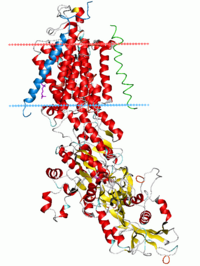
Photo from wikipedia
Endogenous cardiotonic steroids (CTSs), such as telocinobufagin (TCB) and marinobufagin (MBG) contain a lactone moiety critical to their binding and signaling through the Na+/K+-ATPase. Their concentrations elevate in response to… Click to show full abstract
Endogenous cardiotonic steroids (CTSs), such as telocinobufagin (TCB) and marinobufagin (MBG) contain a lactone moiety critical to their binding and signaling through the Na+/K+-ATPase. Their concentrations elevate in response to sodium intake and under volume-expanded conditions. Paraoxonase 3 (PON3) is an enzyme that can hydrolyze lactone substrates. Here, we examine the role of PON3 in regulating CTS levels in a rat model of chronic kidney diseases (CKD). TCB and MBG were extracted from rat urine samples, and the analyses were carried out using ultra-high pressure liquid chromatography–Orbitrap-mass spectrometry (UHPLC-Orbitrap-MS). Ten-week-old Dahl salt-sensitive wild type (SS-WT) and Dahl salt-sensitive PON3 knockout (SS-PON3 KO) rats were maintained on a high-salt diet (8% NaCl) for 8 weeks to initiate salt-sensitive hypertensive renal disease characteristic of this model. CTS extraction recovery from urine >80% was achieved. For animals maintained on a normal chow diet, the baseline amount of TCB excreted in 24 h urine of SS-PON3 KO rats (6.08 ± 1.47 ng/24 h; or 15.09 ± 3.25 pmol) was significantly higher than for SS-WT rats (1.48 ± 0.69 ng/24 h; or 3.67 ± 1.54 pmol, p < 0.05). Similarly, for the same animals, the amount of excreted MBG was higher in the urine of SS-PON3 KO rats (4.74 ± 1.30 ng/24 h versus 1.03 ± 0.25 ng/24 h in SS-WT; or 11.83 ± 2.91 pmol versus 2.57 ± 0.56 pmol in SS-WT, p < 0.05). For animals on a high-salt diet, the SS-PON3 KO rats had significantly increased levels of TCB (714.52 ± 79.46 ng/24 h; or 1774.85 ± 175.55 pmol) compared to SS-WT control (343.84 ± 157.54 ng/24 h; or 854.09 ± 350.02 pmol, p < 0.05), and comparatively higher levels of MBG were measured for SS-PON3 KO (225.55 ± 82.61 ng/24 h; or 563.19 ± 184.5 pmol) versus SS-WT (157.56 ± 85.53 ng/24 h; or 393.43 ± 191.01 pmol, p > 0.05) rats. These findings suggest that the presence and absence of PON3 dramatically affect the level of endogenous CTSs, indicating its potential role in CTS regulation.
Journal Title: International Journal of Molecular Sciences
Year Published: 2022
Link to full text (if available)
Share on Social Media: Sign Up to like & get
recommendations!